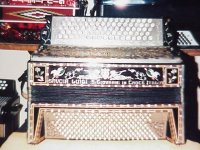Thanks
@snavoyosky, it's lovely to read these little gems of insight. Hearing your words makes me almost yearn for something that I have never known (so have no right to miss it). But, I too am a believer that, as you say "going back in time will place one closer to the truth", or at least something special...
I sometimes think, if only I go back to an earlier time and speak to Mr Gola and ask... please can you make me a piano accordion with 41 keys, 120 basses with double cassotto, a model Gola 414 will be perfect, but can you add 3 octaves Quint free bass for me too? What he might have produced would leave me speechless.
But alas the days of Mr Gola, and the glories of Scandalli, Excelsior, Victoria etc. are faded memories, relived still in the beautiful tones of old accordions that Galliano or Van Damme and many other accordionists have played.
It is a pleasure listening to your words and I hope you continue to share your many experiences with us for a long time to come.
Stewart
Thank you for your support, Stewart. I have no intent to close the door on history for we wouldn't be here if it wasn't for history. I'll give you and others an example of how history really pre-empted technology in regard to the bass section.
The Russians came forth with their bass section advancement that introduced 'single note' changeover from the stradella chords and also back to chords at will. One was made and used by Yuri Korsakov, Russia's best at the time. I forget the exact date now but I still have that LP vinyl record by Angel records of him doing all this fantastic music on a Russian accordion with sparkling harmonic reeds..........and "both sides playing against the middle". I chance a guess on the time element and say I bought that record in the middle 1950s....so this "Russian invention" transpired before that time.
Subsequently my longtime friend Julio Giulietti introduced the 'free bass' which added three chromatic single tone button rows next to the stradella bass and the three chromatic rows were located between the stradella bass and the bellows. How did this happen? Italy acquired one of those Russian Bayans to study and develop their own manufacture of single notes on that side and decided to keep the stradella as is and add those three rows. Since all Golas and Morinos contained Italian reeds instead of German reeds, Golas were also made with those three extra rows.
But here's the problem and why it became a problem for Italian free bass. Enter Mogens Ellegaard from Denmark who became part of that design group and who believe the low notes of the free bass should start at the top with the high notes at the bottom. It was done that way and really the most illogical way. Why? The test of any musical system is the ease of sightreading material. Think piano keyboard and realize that the 5th finger plays the lowest notes. The Russian freebass system has the lowest tone with the 5th finger. Sightreading is logical. When I had my special bassetti built I had 6 rows of chromatic free bass made with that "B chromatic system" and upon first play of a Chopin Prelude......it was easy to execute.
But I digress.....my point is this from above. Technology speaking......everyone was claiming, including Julio, that he developed the chromatic free bass with those three rows beside the stradella. And Russia claimed the development of changing the stradella system to B chromatic.
And me? I go to my accordion store and on the shelve is this instrument from the turn of the century (going back in time really does give us the truth)



